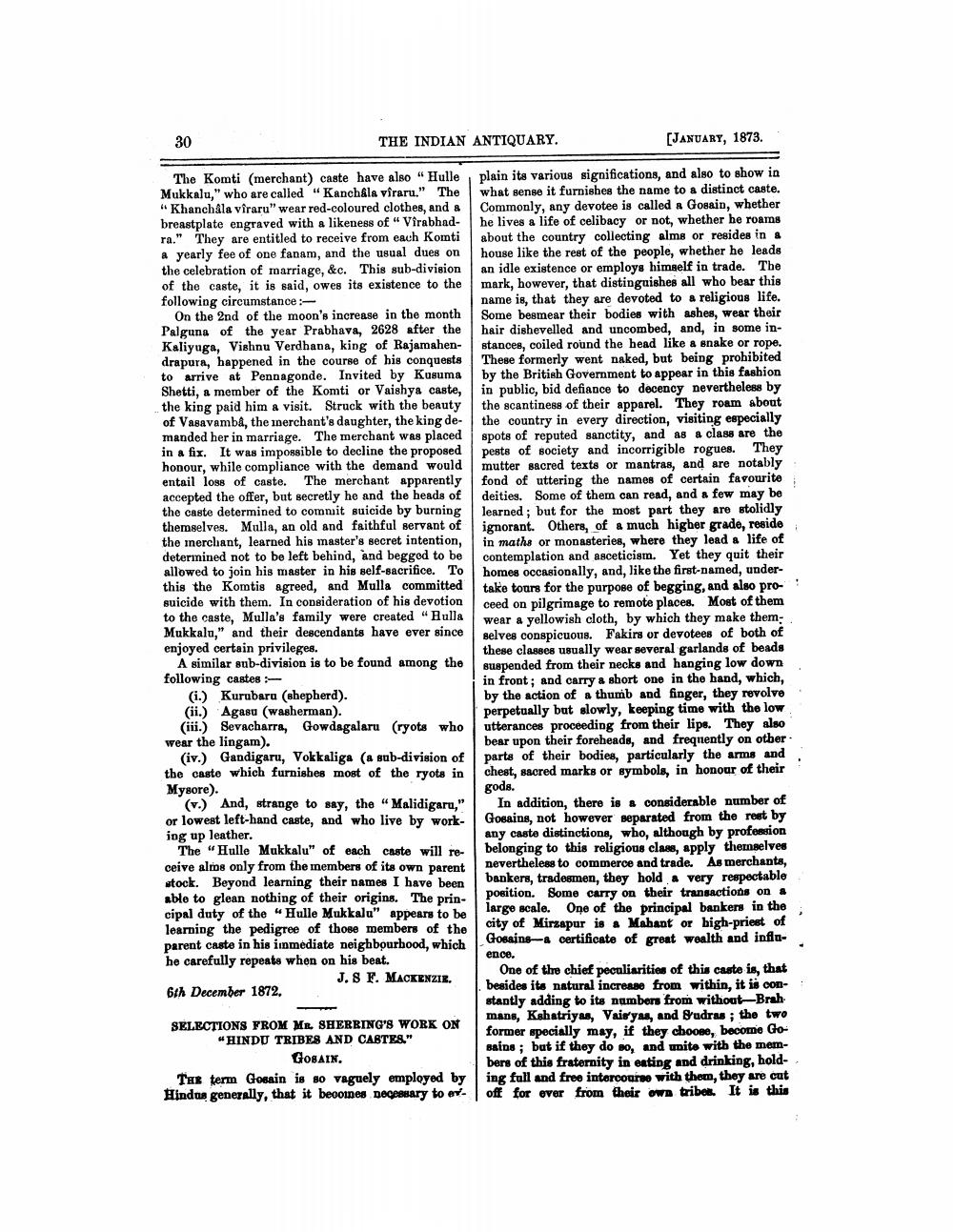________________
30
THE INDIAN ANTIQUARY.
[JANUARY, 1873.
The Komti (merchant) caste have also "Hulle, plain its various significations, and also to show in Mukkalu," who are called "Kanchala viraru." The what sense it furnishes the name to a distinct caste. "Khanchåla viraru" wear red-coloured clothes, and a Commonly, any devotee is called a Gowain, whether breastplate engraved with a likeness of " Virabhad- he lives a life of celibacy or not, whether he roams ra." They are entitled to receive from each Komti about the country collecting alms or resides in a a yearly fee of one fanam, and the usual dues on house like the rest of the people, whether he leads the celebration of marriage, &c. This sub-division an idle existence or employs himself in trade. The of the caste, it is said, owes its existence to the mark, however, that distinguishes all who bear this following circumstance
name is, that they are devoted to a religious life. On the 2nd of the moon's increase in the month Some besmear their bodies with ashes, wear their Palguna of the year Prabhava, 2628 after the hair dishevelled and uncombed, and, in some inKaliyuga, Vishnu Verdhana, king of Rajamahen- stances, coiled round the head like a snake or rope. drapura, happened in the course of his conquests These formerly went naked, but being prohibited to arrive at Pennagonde. Invited by Kusuma by the British Government to appear in this fashion Shetti, a member of the Komti or Vaishya caste, in public, bid defiance to decency nevertheless by the king paid him a visit. Struck with the beauty the scantiness of their apparel. They roam about of Vasavamba, the inerchant's daughter, the king de- the country in every direction, visiting especially manded her in marriage. The merchant was placed spots of reputed sanctity, and as a class are the in a fix. It was impossible to decline the proposed pests of society and incorrigible rogues. They honour, while compliance with the demand would mutter sacred texts or mantras, and are notably entail loss of caste. The merchant apparently fond of uttering the names of certain favourite accepted the offer, but secretly he and the heads of deities. Some of them can read, and a few may be the caste determined to commit suicide by burning learned; but for the most part they are stolidly themselves. Mulla, an old and faithful servant of ignorant. Others, of a much higher grade, reside the merchant, learned his master's secret intention,
in maths or monasteries, where they lead a life of determined not to be left behind, and begged to be contemplation and asceticism. Yet they quit their allowed to join his master in his self-sacrifice. To homes occasionally, and, like the first-named, underthis the Komtis agreed, and Mulla committed take tours for the purpose of begging, and also prosuicide with them. In consideration of his devotion
ceed on pilgrimage to remote places. Most of them to the caste, Mulla's family were created "Hulla
wear a yellowish cloth, by which they make them Mukkalu," and their descendants have ever since
Belves conspicuous. Fakirs or devotees of both of enjoyed certain privileges.
these classes usually wear several garlands of beads A similar sub-division is to be found among the
suspended from their necks and hanging low down following castes
in front; and carry a short one in the hand, which, (i.) Kurubaru (shepherd).
by the action of a thumb and finger, they revolve (ii.) Agasu (washerman).
perpetually but slowly, keeping time with the low (iii.) Sevacharra, Gowdagalaru (ryota who utterances proceeding from their lips. They also wear the lingam).
bear upon their foreheads, and frequently on other (iv.) Gandigaru, Vokkaliga (a sub-division of parts of their bodies, particularly the arms and the casto which furnishes most of the ryots in chest, sacred marks or symbols, in honour of their Mysore)
gods. (v.) And, strange to say, the “Malidigaru," In addition, there is & considerable number of or lowest left-hand caste, and who live by work
Gosains, not however separated from the rest by ing up leather.
any caste distinctions, who, although by profession The "Hulle Mukkalu" of each caste will re
belonging to this religious class, apply themselves ceive alms only from the members of its own parent nevertheless to commerce and trade. As merchants, stock. Beyond learning their names I have been
bankers, tradesmen, they hold a very respectable able to glean nothing of their origins. The prin
position. Some carry on their transactions on & cipal duty of the “Hulle Mukkalu" appears to be
large scale. One of the principal bankers in the learning the pedigree of those members of the
city of Mirzapur is a Mahant or high-priest of parent caste in his immediate neighbourhood, which Gosains--a certificate of great wealth and influho carefully repeats when on his beat.
ence. J.SF. MACKENZIE.
One of the chief peculiarities of this caste is, that 6th December 1872,
besides its natural increase from within, it is con
stantly adding to its numbers from without-Brah SELECTIONS FROM ME SHERRING'S WORK ON
mans, Kshatriyas, Vaisyas, and Budras; the two *HINDU TRIBES AND CABTES."
former specially may, if they choose, become Go
Bains; but if they do no, and unite with the memGOBAIN.
bers of this fraternity in eating and drinking, holdThe term Gosain is so vaguely employed by ing full and free intercourse with them, they are cut Hindas generally, that it beooines necessary to ex. off for over from their own tribes. It is this




